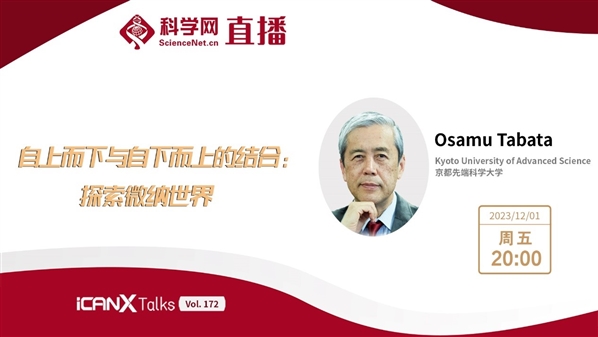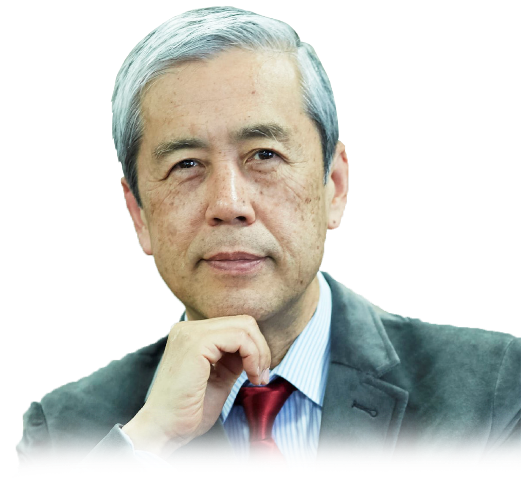|
|
|
|
|
京都先端科学大学教授Osamu Tabata讲述自上而下与自下而上的结合:探索微纳世界 |
|
|

直播时间:2023年12月1日(周五)20:00-21:30
直播平台:

科学网APP
https://weibo.com/l/wblive/p/show/1022:2321324974084130996593
(科学网微博直播间链接)

科学网微博

科学网视频号
北京时间2023年12月1日晚八点,iCANX Talks 第172期邀请京都先端科学大学的Osamu Tabata教授进行分享!更多精彩,敬请期待!
【嘉宾介绍】

Osamu Tabata
京都先端科学大学
Top-down meets bottom-up:Way to explore the plentiful room at the bottom
【Abstract】
In 1982 two papers in particular were published. One is recognized as the bible of Silicon micromachining, which is a typical top-down approach to miniaturization, and the other is known as the origin of DNA nanotechnology, which is a typical bottom-up approach to realizing nanoscale objects. Almost 40 years later the former is still the key to MEMS and the latter is the key to molecular machines. Both of these have been developed continuously and are now recognized as powerful technologies and yet there remains a significant gap between them.
In this talk, I begin by introducing the historical aspects of these two approaches to exploring the world at micro and nano scales. I then introduce the Body of a Chip concept as an example of the application of MEMS technology. As an application of DNA nanotechnology, a nanoscale ultra-high sensitive molecular sensor based on the gold nanoparticle dimer is presented. At the end of my talk, one challenging goal that remains to be addressed is proposed.
1982 年,有两篇论文发表。一篇被认为是硅微机械加工的圣经,这是一种典型的自上而下的微型化方法;另一篇被认为是 DNA 纳米技术的起源,这是一种典型的自下而上的实现纳米级物体的方法。 近 40 年后,前者仍然是微机电系统的关键,后者则是分子机器的关键。这两种技术都得到了不断发展,现已被公认为强大的技术,但两者之间仍存在很大差距。
在本讲座中,Osamu Tabata首先介绍这两种在微米和纳米尺度上探索世界的方法的历史渊源。然后以 "芯片人体"(Body of a Chip)概念为例,介绍了微机电系统(MEMS)技术的应用。作为 DNA 纳米技术的应用,Osamu Tabata将介绍一种基于金纳米粒子二聚体的纳米级超高灵敏度分子传感器。在演讲的最后,提出一个有待解决的挑战性目标。
【BIOGRAPHY】
Osamu Tabata received his M.S. and Ph.D. degrees from Nagoya Institute of Technology, Japan, in 1981 and 1993, respectively. In 1981, he joined Toyota Central Research and Development Laboratories, Inc., Japan. In 1996, he joined the Department of Mechanical Engineering at Ritsumeikan University, Japan. In 2003, he moved to the Graduate School of Engineering, Kyoto University, Japan. In October 2019, he moved to Kyoto University of Advanced Science as a founding Dean of the Faculty of Engineering and Graduate School of Engineering. From 2022, he also has been appointed the Executive Vice President. He has been engaged in research on micro/nano processes, MEMS, and DNA Nanotechnology. Prof. Tabata was a guest professor at several Universities such as ETH Zurich Switzerland. Since 2020, he is an IEEE EDS Award Committee Member. He is a Fellow of the Institute of Electrical and Electronics Engineers and the Institute of Electrical Engineers Japan.
Osamu Tabata 分别于 1981 年和 1993 年获得日本名古屋工业大学硕士和博士学位。1981 年,他加入日本丰田中央研究开发实验室。1996 年,他加入日本立命馆大学机械工程系。2003 年,调入日本京都大学大学院工学研究科。2019 年 10 月,他调任京都先端科学大学,担任工学部和工学研究生院的创始院长。从 2022 年起,他还被任命为常务副校长。他一直从事微/纳米工艺、微机电系统和 DNA 纳米技术的研究。田畑端教授曾在瑞士苏黎世联邦理工学院等多所大学担任客座教授。自 2020 年以来,他一直是电气和电子工程师学会 EDS 奖委员会成员。他是电气与电子工程师学会和日本电气工程师学会的会员。
特别声明:本文转载仅仅是出于传播信息的需要,并不意味着代表本网站观点或证实其内容的真实性;如其他媒体、网站或个人从本网站转载使用,须保留本网站注明的“来源”,并自负版权等法律责任;作者如果不希望被转载或者联系转载稿费等事宜,请与我们接洽。